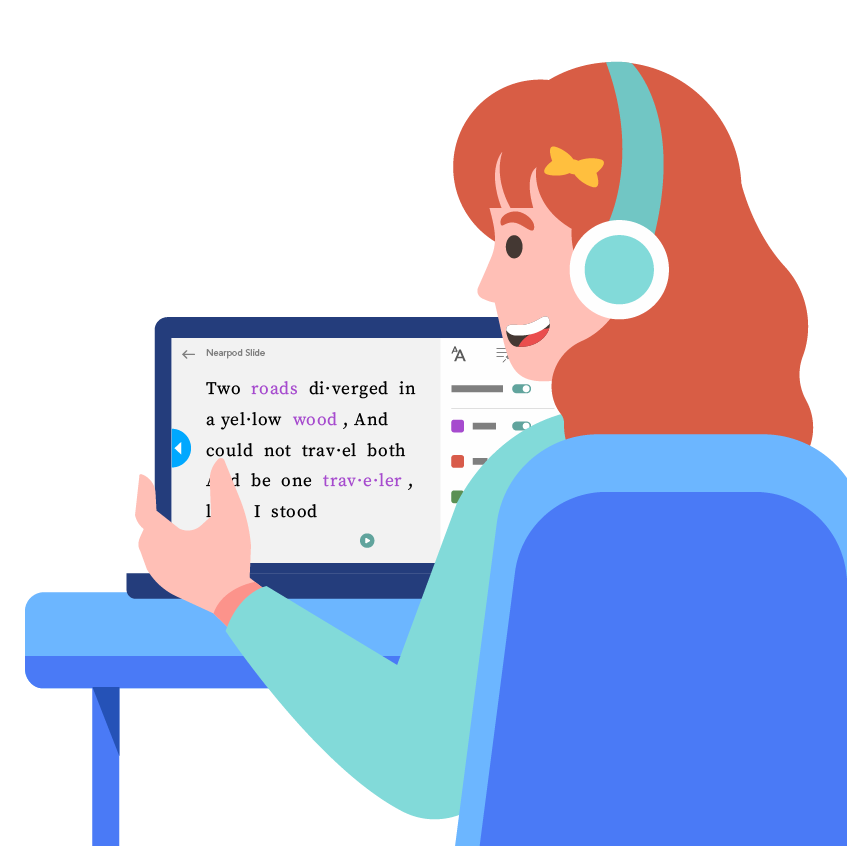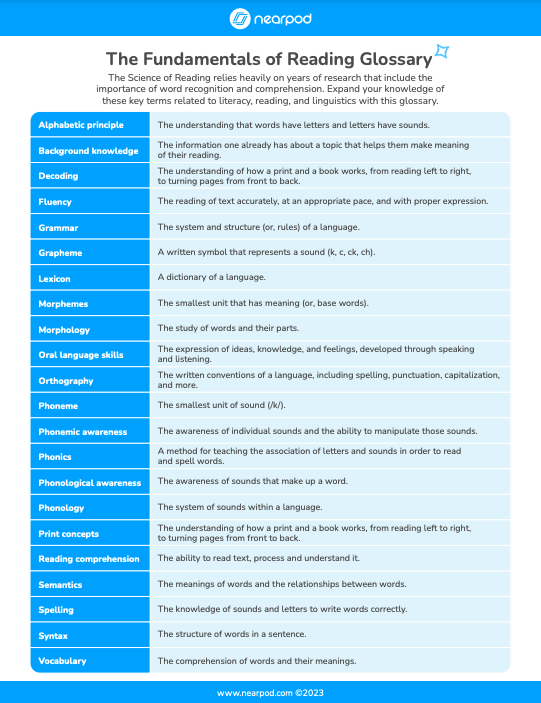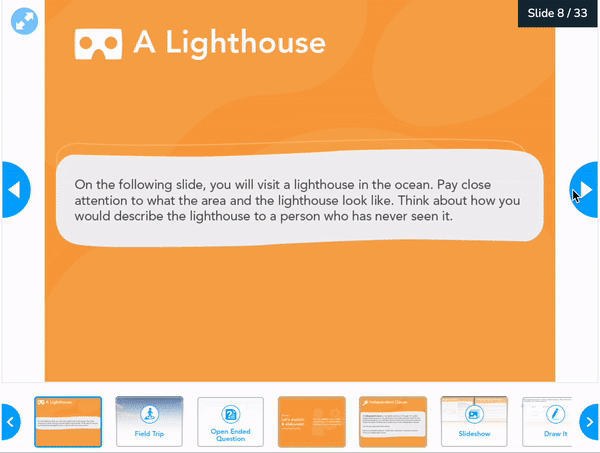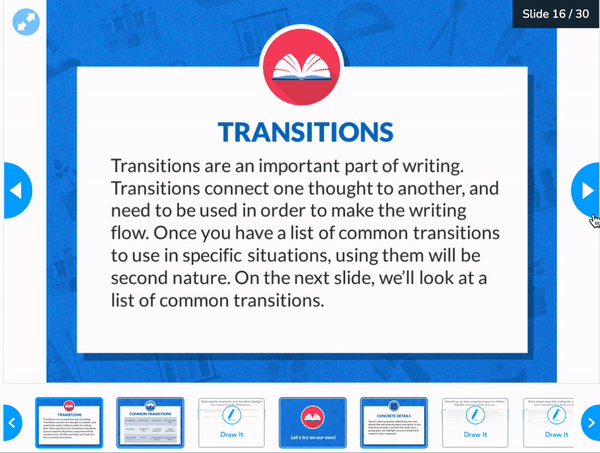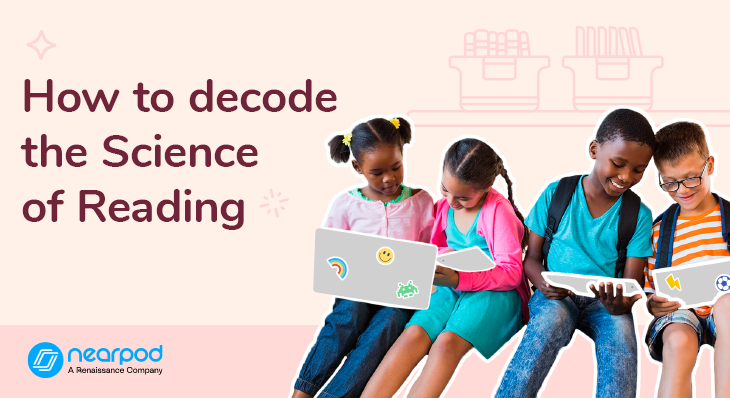
- English language arts
- Instructional resources
- Leadership
- Pedagogy
- Teachers
- Thought leadership
- Trends in education
How to decode the Science of Reading
You’ve probably heard the buzz around the Science of Reading (SOR). You may even be asking, “What does it mean? How does it differ from what we’re currently doing?” New research is emerging about children’s brain development and how educators’ pedagogy can best address learning goals. A growing body of research leads to debate about the methodologies and logic behind SOR. Even amid the disagreement, it’s good to reflect on your school’s approaches to literacy. It could spark a healthy conversation (but, hopefully, not a literacy war) among practitioners.
New to Nearpod? Teachers can sign up for free below to access these resources, interactive activities, and engaging lessons. Administrators can schedule a call with an expert to unlock the full power of Nearpod for schools and districts.
What is the great debate around the Science of Reading?
Let’s start with the basics: what is literacy? Literacy is the ability to read, write, speak, and listen. Over the decades, schools have shifted to adopt new theories and philosophies. Phonics, whole language, or balanced literacy are all monikers for how educators can teach students how to read. The Science of Reading (or SOR) is not a program. It’s the culmination of decades of research supporting a return to a highly structured set of approaches rooted in decoding skills and language comprehension. It is grounded in efficacy-based research, deconstructing how and why particular models of instruction work.
Balanced Literacy Vs. Science of Reading
For years, balanced literacy sought to find a middle ground between the pendulum extremes of phonics-first and whole-language advocates. Teachers shared their toolbox of strategies with students, from decoding to “three-cueing” to leveled readers. Yet such programs have been hard to evaluate in terms of efficacy. SOR education focuses on decoding and language comprehension.
Research shows that reading, unlike talking, is not a natural process for children. It takes more intentional instruction to achieve desired results and goals. Proponents of the Balanced Literacy vs Science of Reading point to the recent decline in reading scores as evidence that the prevalent methods of reading instruction over the past decade have failed. The Science of Reading emphasizes the importance of mastering foundational skills through a structured literacy approach to ensure effective strategies for learning to read.
Why is the Science of Reading important right now?
It’s hard to argue that we’re not in a reading crisis. Reading skills have declined in districts and states nationwide to historic lows. The learning loss during the COVID-19 pandemic widened reading and math achievement gaps. It spotlighted the increasing discrepancy for Black, Hispanic, and other students impacted by educational inequalities. EdWeek reported that student results from the 2022 National Assessment of Educational Progress (NAEP) showcased that a third of 4th and 8th graders can’t read at the “basic” achievement level, which is the lowest. 70% of teachers of those 4th-grade students reported using remedial measures a couple of times a week. According to the results, even top readers have made little progress over the past three years. This lack of growth and widening gaps have turned educators and parents’ attention to what can be done differently regarding the SOR.
This map shows students from grade 4 scoring below basic in reading, by state:
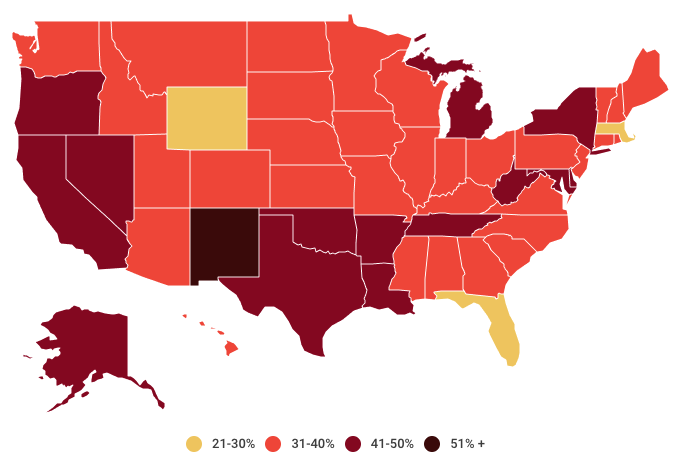
What is the Science of Reading?
Many states have now adopted a much more rigorous approach to reading. The SOR approach zeros in on developing five core skill sets for emergent and beginner readers: fluency, phonemic awareness, vocabulary, phonics, and comprehension. It harkens back to 1986’s The Simple View of Reading research by Philip Gough and William Tunmer, which underscores the importance of two components: decoding and language comprehension. Think of it as an equation—reading comprehension is a product of decoding and language comprehension: RC = D x LC.
The algorithm’s simplicity belies the intricate and sophisticated sensemaking of letter sounds, words, and sentences. Dr. Hollis Scarborough’s 2021 Scarborough’s Rope Reading further details how the two intertwine, scaffolding skills and building toward automaticity.
With the SOR, instruction involves dedicated time and a systematic and intentional method of seeking out teachable moments for literacy across the curriculum. This evidence-based approach encourages educators to lean on what matters and what works. Turning research into practice, however, is not without time, effort, and money.
Here are the 10 components of the SOR:
- Print concepts
- Phonological awareness
- Phonemic awareness
- Phonics
- Spelling
- Fluency
- Vocabulary
- Oral language skills
- Reading comprehension skills
- Background knowledge
To better understand Science of Reading strategies, look at this downloadable to refresh your understanding of key concepts and terms. Remember, there is no specific curriculum or program, so you’ll want to work with your school community to determine how to fold in these demonstrated methods.
How are states implementing the SOR?
States are falling victim to the age-old problem of education stumbling over change management. Many are pushing this newer school of thought with little explanation. Such harried rollouts breed confusion, suspicion, and defensiveness. Teachers are told to change their “best” practices and beliefs without time to make connections to the new methodologies. Timelines, incentives, and compensation are not being offered equitably. This push-and-pull pits educators against one another, and against change in general.
Tennessee, Florida, North Carolina, Colorado, and Mississippi have passed laws requiring a SOR approach. Others are going in with intensive training and Science of Reading professional development, overwhelming an already taxed and deflated teacher population. North Carolina is spending $54 million on a two-year training (LETRS) for all K-5 teachers. A common refrain is, “When you know better, you do better.” Many other states, such as Utah and Virginia, are leveraging ESSER funds to adopt such practices via instruction and training. However, the integration and implementation nationwide are uneven at best.
What are the benefits of the Science of Reading?
Time will tell; the benefits are to be seen. On the positive side, such a common and structured approach based on research should be easier to track and see results. According to a study by Amplify, many students in 43 states are seeing an uptick in the number of students on track to read at grade level by the end of the year.
The Science of Reading curriculum takes a scaffolded approach, promotes reading across the curriculum, and supports English language learners. While school leaders need to think systematically around benchmark assessments, resource allocation, and professional development, they also need to remember that teaching is both a science and an art.
Edtech implementation
Nearpod
According to an ESSA Level II study, 5th and 8th-grade students who used Nearpod had higher ELA achievement compared to similar students in their grade level who did not use it. This makes it an ideal tool when implementing SOR strategies. To explore some related Nearpod Science of Reading activities and lessons, visit the Nearpod library and search by standard. You can zero in on the English Language Arts (ELA) strands of Conventions of Standard English, Vocabulary Acquisition and Use, Knowledge of Language, Phonics, Word Recognition, Fluency, Key Ideas and Details, Craft and Structure, Integration of Knowledge and Ideas, or Range of Reading and Level of Text Complexity to start. Consider duplicating a lesson and making modifications to meet the reading needs of your students.
You can also create your own lesson or activity to target any of the 10 components of SOR instruction. Interactive activities such as Drag and Drop, Matching Pairs, Draw It, Immersive Reader, and audio responses can be used to teach your students fluency, phonemic awareness, vocabulary, phonics, and comprehension.
Here are some examples of lessons teachers can use:
Early Elementary Lessons (K-2)
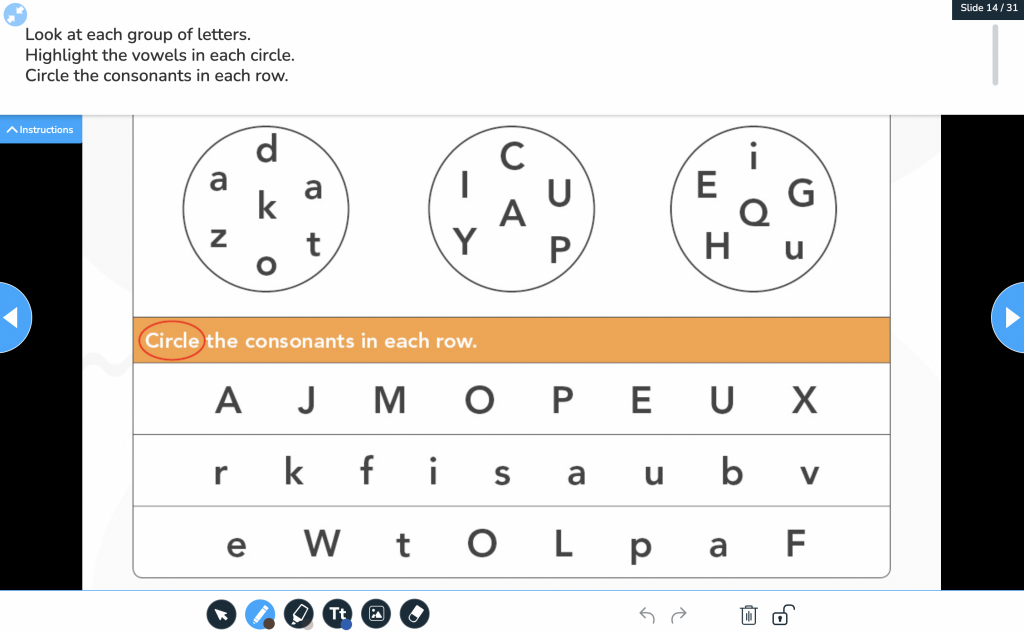
- CVC Words (K-1): In this lesson on CVC words, students will learn to idenifty the beginning, middle and ending sounds of CVC words.
- Nonfiction Text Features (1-2): In this lesson on nonfiction text features, students will learn about features that help readers make sense of what they are reading.
- Retelling Key Details (1-2): In this lesson on retelling key details, students learn to identify and retell key details in a fiction story.
Grades 3-5
- Parts of Speech (3): In this lesson on parts of speech, students will identify nouns, verbs, adverbs and adjectives.
- Complex Sentences (3-4): In this lesson on complex sentences, the students will review simple and compound sentences and learn about complex sentences.
- Eight Parts of Speech (5-6): In this lesson on the eight parts of speech, students will define, identify, and use nouns, pronouns, verbs, adverbs, adjectives, prepositions, conjunctions, and articles.
Grade 8-12
- Summarizing Texts (6-8): In this lesson on summarizing texts, students how to write a summary by identifying the main idea and key details.
- Annotation and Close Reading Strategies (11-12): In this English lesson, students learn annotation and close reading strategies. By the end of this lesson, students will be able to explain tips and tricks for effective close reading, and will practice annotating excerpts.
- The Paragraph: Concrete Details & Textual Evidence (9-10): In this lesson, students will explore the components of a good paragraph. They will learn to identify appropriate concrete details and practice using them with common transitions to strengthen an argument in a logical way.
Flocabulary
Flocabulary accelerates student learning by building academic vocabulary and comprehension through rigorous and authentically engaging instructional experiences. These K-12 standard-aligned video-based lessons and activities leverage the power of hip-hop, storytelling, and emotional connections to cultivate literacy across the curriculum.
Academic vocabulary is a leading indicator of student comprehension. Flocabulary strategically uses hip-hop as the foundational medium to teach vocabulary and provide the necessary in-context word exposure. While it starts in the video, Flocabulary infuses aspects of hip-hop throughout the lesson sequence. For example, students unlock components of a hip-hop beat while completing the Vocab Game and are tasked with writing a rhyme of their own in Lyric Lab.
The Art & Science of Reading
While we continue to research and seek improved methods for teaching SOR reading strategies — and all subjects—we also need to remember that educators are tasked with molding lifelong learners. In part, when it comes to literacy instruction, they need to promote a love of reading, extol the beauty of wordplay, and develop an appreciation for storytelling in children. We know that one size does not fit all in education. So we need to rely on quantitative and qualitative data and make time for continuous feedback and reflection inside and outside the classrooms to create skilled readers and masterful literacy educators.
Nearpod believes teaching is the most important job in the world. That’s why we’ve created a platform to help teachers engage every student. Nearpod offers 22,000+ rigorous lessons, videos, and activities used by 75% of school districts in the United States alone. If you’re ready to unlock the full instructional power of Nearpod at your school or district, we’re ready to talk!
New to Nearpod? Teachers can sign up for free below to access these resources, interactive activities, and engaging lessons. Administrators can schedule a call with an expert to unlock the full power of Nearpod for schools and districts.
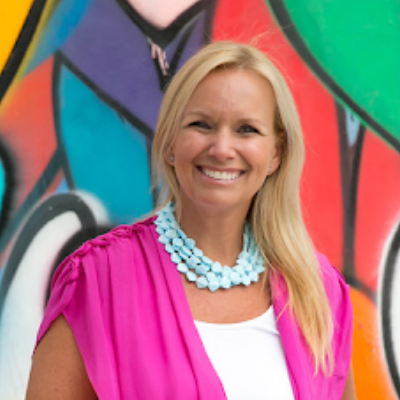
Darri Stephens is a dedicated LX (learning experience) designer, passionate about creating quality content and programs for kids, families, and educators. With MAs in Education from both Harvard and Stanford, and work experience at best-in-class ed tech organizations including Wonder Workshop, Nickelodeon, and Common Sense Education, she is steeped in the design thinking process and committed to agile and iterative project management, which has resulted in multi-award-winning programs and products.
